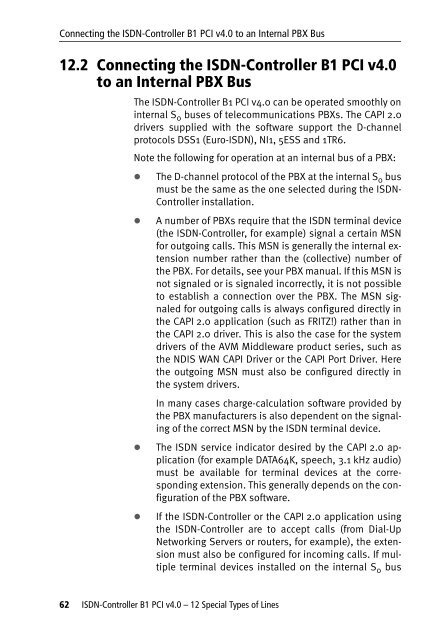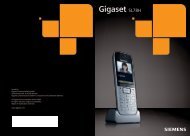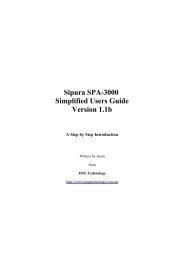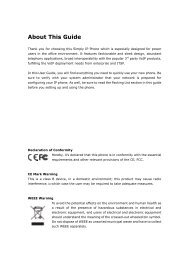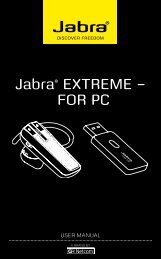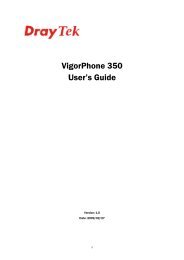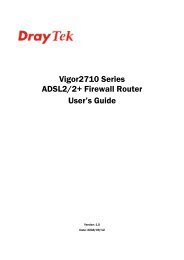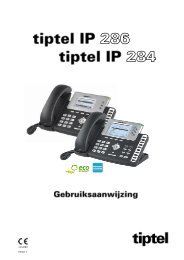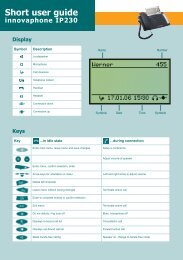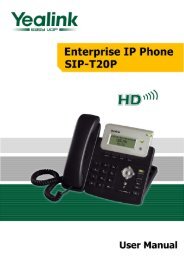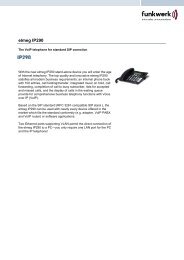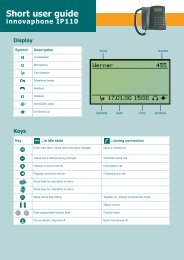1 The AVM ISDN-Controller B1 PCI v4.0 - VoipAndGo
1 The AVM ISDN-Controller B1 PCI v4.0 - VoipAndGo
1 The AVM ISDN-Controller B1 PCI v4.0 - VoipAndGo
Create successful ePaper yourself
Turn your PDF publications into a flip-book with our unique Google optimized e-Paper software.
Connecting the <strong>ISDN</strong>-<strong>Controller</strong> <strong>B1</strong> <strong>PCI</strong> <strong>v4.0</strong> to an Internal PBX Bus<br />
12.2 Connecting the <strong>ISDN</strong>-<strong>Controller</strong> <strong>B1</strong> <strong>PCI</strong> <strong>v4.0</strong><br />
to an Internal PBX Bus<br />
<strong>The</strong> <strong>ISDN</strong>-<strong>Controller</strong> <strong>B1</strong> <strong>PCI</strong> <strong>v4.0</strong> can be operated smoothly on<br />
internal S0 buses of telecommunications PBXs. <strong>The</strong> CAPI 2.0<br />
drivers supplied with the software support the D-channel<br />
protocols DSS1 (Euro-<strong>ISDN</strong>), NI1, 5ESS and 1TR6.<br />
Note the following for operation at an internal bus of a PBX:<br />
� <strong>The</strong> D-channel protocol of the PBX at the internal S 0 bus<br />
must be the same as the one selected during the <strong>ISDN</strong>-<br />
<strong>Controller</strong> installation.<br />
� A number of PBXs require that the <strong>ISDN</strong> terminal device<br />
(the <strong>ISDN</strong>-<strong>Controller</strong>, for example) signal a certain MSN<br />
for outgoing calls. This MSN is generally the internal extension<br />
number rather than the (collective) number of<br />
the PBX. For details, see your PBX manual. If this MSN is<br />
not signaled or is signaled incorrectly, it is not possible<br />
to establish a connection over the PBX. <strong>The</strong> MSN signaled<br />
for outgoing calls is always configured directly in<br />
the CAPI 2.0 application (such as FRITZ!) rather than in<br />
the CAPI 2.0 driver. This is also the case for the system<br />
drivers of the <strong>AVM</strong> Middleware product series, such as<br />
the NDIS WAN CAPI Driver or the CAPI Port Driver. Here<br />
the outgoing MSN must also be configured directly in<br />
the system drivers.<br />
In many cases charge-calculation software provided by<br />
the PBX manufacturers is also dependent on the signaling<br />
of the correct MSN by the <strong>ISDN</strong> terminal device.<br />
� <strong>The</strong> <strong>ISDN</strong> service indicator desired by the CAPI 2.0 application<br />
(for example DATA64K, speech, 3.1 kHz audio)<br />
must be available for terminal devices at the corresponding<br />
extension. This generally depends on the configuration<br />
of the PBX software.<br />
� If the <strong>ISDN</strong>-<strong>Controller</strong> or the CAPI 2.0 application using<br />
the <strong>ISDN</strong>-<strong>Controller</strong> are to accept calls (from Dial-Up<br />
Networking Servers or routers, for example), the extension<br />
must also be configured for incoming calls. If multiple<br />
terminal devices installed on the internal S 0 bus<br />
62 <strong>ISDN</strong>-<strong>Controller</strong> <strong>B1</strong> <strong>PCI</strong> <strong>v4.0</strong> – 12 Special Types of Lines


